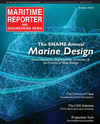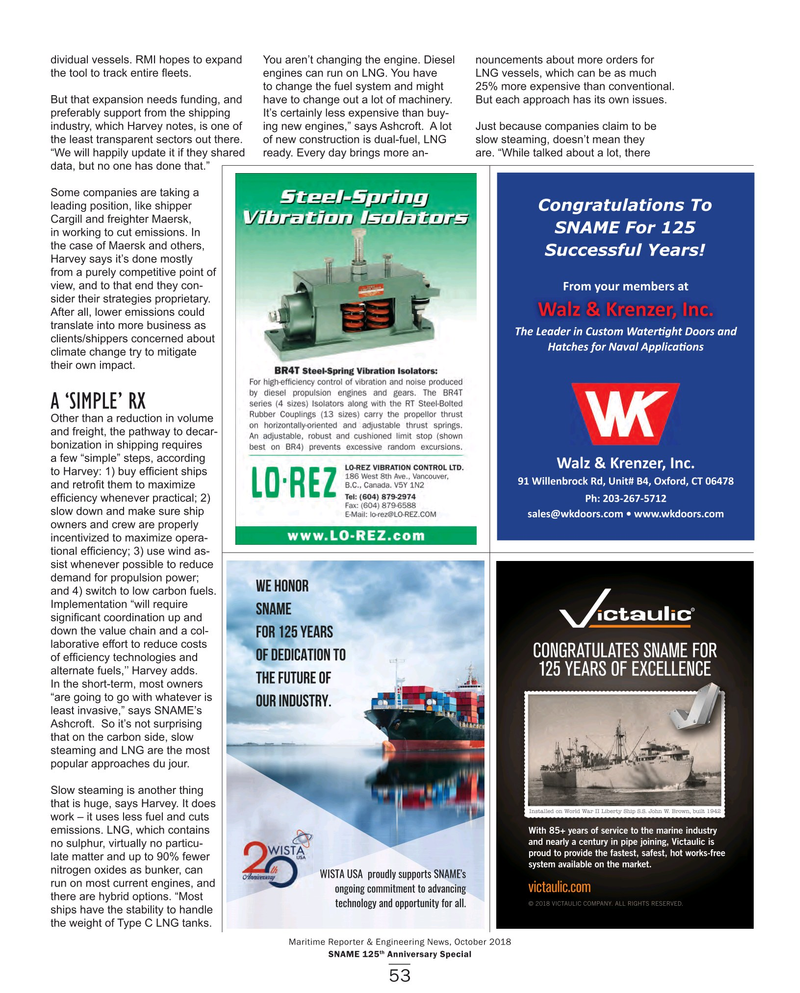
Page 53: of Maritime Reporter Magazine (October 2018)
Marine Design Annual
Read this page in Pdf, Flash or Html5 edition of October 2018 Maritime Reporter Magazine
dividual vessels. RMI hopes to expand You aren’t changing the engine. Diesel nouncements about more orders for the tool to track entire ? eets. engines can run on LNG. You have LNG vessels, which can be as much to change the fuel system and might 25% more expensive than conventional.
But that expansion needs funding, and have to change out a lot of machinery. But each approach has its own issues. preferably support from the shipping It’s certainly less expensive than buy- industry, which Harvey notes, is one of ing new engines,” says Ashcroft. A lot Just because companies claim to be the least transparent sectors out there. of new construction is dual-fuel, LNG slow steaming, doesn’t mean they “We will happily update it if they shared ready. Every day brings more an- are. “While talked about a lot, there data, but no one has done that.”
Some companies are taking a leading position, like shipper
Congratulations To
Cargill and freighter Maersk,
SNAME For 125 in working to cut emissions. In the case of Maersk and others,
Successful Years!
Harvey says it’s done mostly from a purely competitive point of view, and to that end they con-
From your members at sider their strategies proprietary.
After all, lower emissions could
Walz & Krenzer, Inc.
translate into more business as dSG>GAEG?sY??lŽwtAlG?OOSlŽŽ??AYE clients/shippers concerned about ,AlÐSG?IŽ?EA|AuÐÐusÐAOŽY?
climate change try to mitigate their own impact.
A ‘SIMPLE’ RX
Other than a reduction in volume and freight, the pathway to decar- bonization in shipping requires a few “simple” steps, according
Walz & Krenzer, Inc.
to Harvey: 1) buy ef? cient ships 91 Willenbrock Rd, Unit# B4, Oxford, CT 06478 and retro? t them to maximize ef? ciency whenever practical; 2) Ph: 203-267-5712 slow down and make sure ship ?AuG???UEŽŽ???ÐŽw??????UEŽŽ???ÐŽw owners and crew are properly incentivized to maximize opera- tional ef? ciency; 3) use wind as- sist whenever possible to reduce demand for propulsion power;
We honor and 4) switch to low carbon fuels.
Implementation “will require
SNAME signi? cant coordination up and down the value chain and a col-
For 125 years laborative effort to reduce costs
CONGRATULATES SNAME FOR of dedication to of ef? ciency technologies and alternate fuels,’’ Harvey adds.
125 YEARS OF EXCELLENCE the future of
In the short-term, most owners “are going to go with whatever is our industry. least invasive,” says SNAME’s
Ashcroft. So it’s not surprising that on the carbon side, slow steaming and LNG are the most popular approaches du jour.
Slow steaming is another thing that is huge, says Harvey. It does
Installed on World War II Liberty Ship S.S. John W. Brown, built 1942 work – it uses less fuel and cuts
With 85+ years of service to the marine industry emissions. LNG, which contains and nearly a century in pipe joining, Victaulic is no sulphur, virtually no particu- proud to provide the fastest, safest, hot works-free late matter and up to 90% fewer system available on the market. nitrogen oxides as bunker, can
WISTA USA? proudly supports SNAME's run on most current engines, and victaulic.com ongoing commitment to advancing there are hybrid options. “Most © 2018 VICTAULIC COMPANY. ALL RIGHTS RESERVED.
technology and opportunity for all. ships have the stability to handle the weight of Type C LNG tanks.
Maritime Reporter & Engineering News, October 2018 th
SNAME 125 Anniversary Special 53
MR #10 (50-57).indd 53 MR #10 (50-57).indd 53 10/5/2018 12:03:21 PM10/5/2018 12:03:21 PM

 52
52

 54
54
